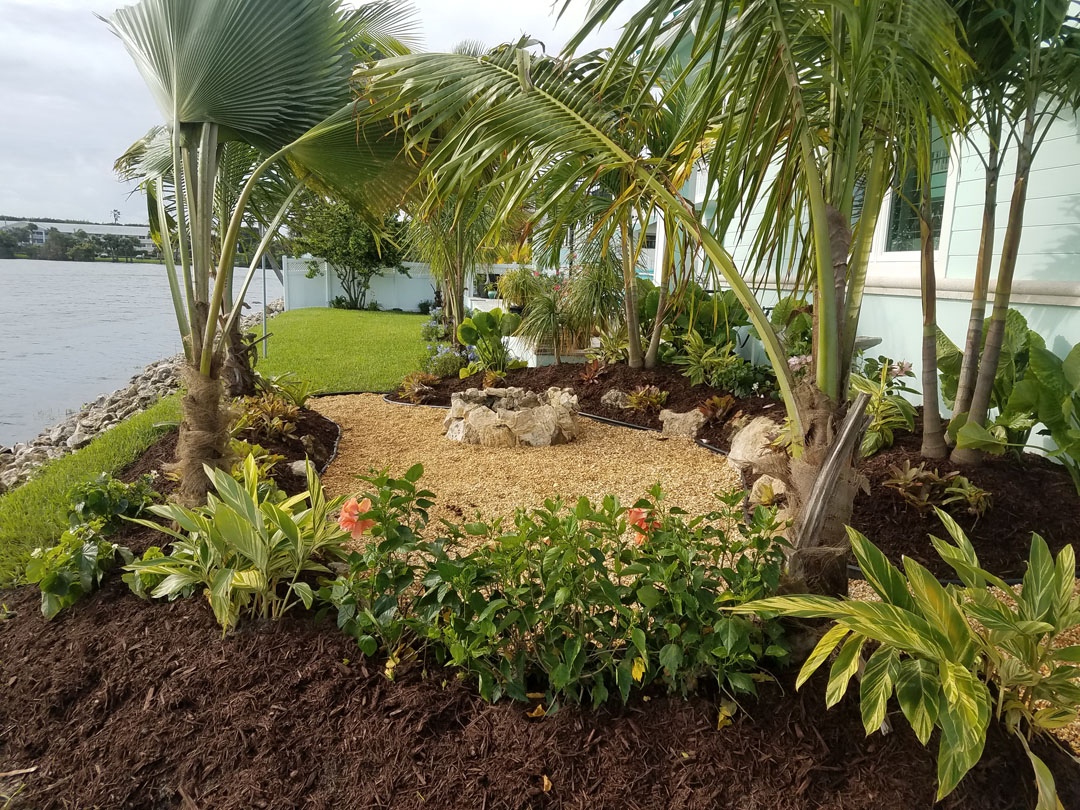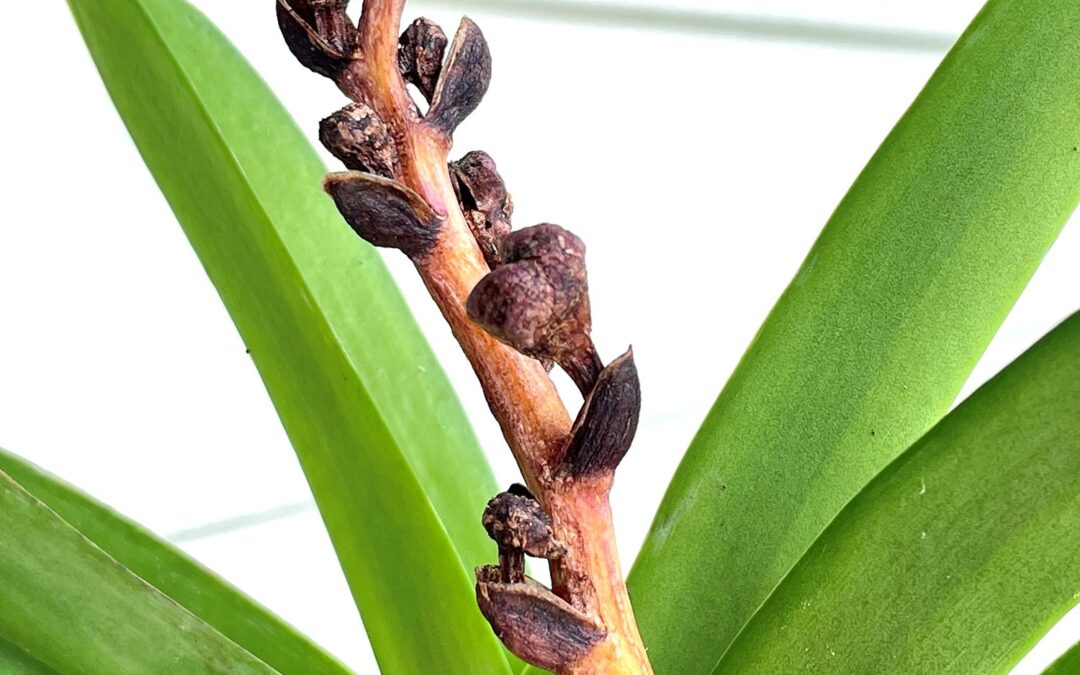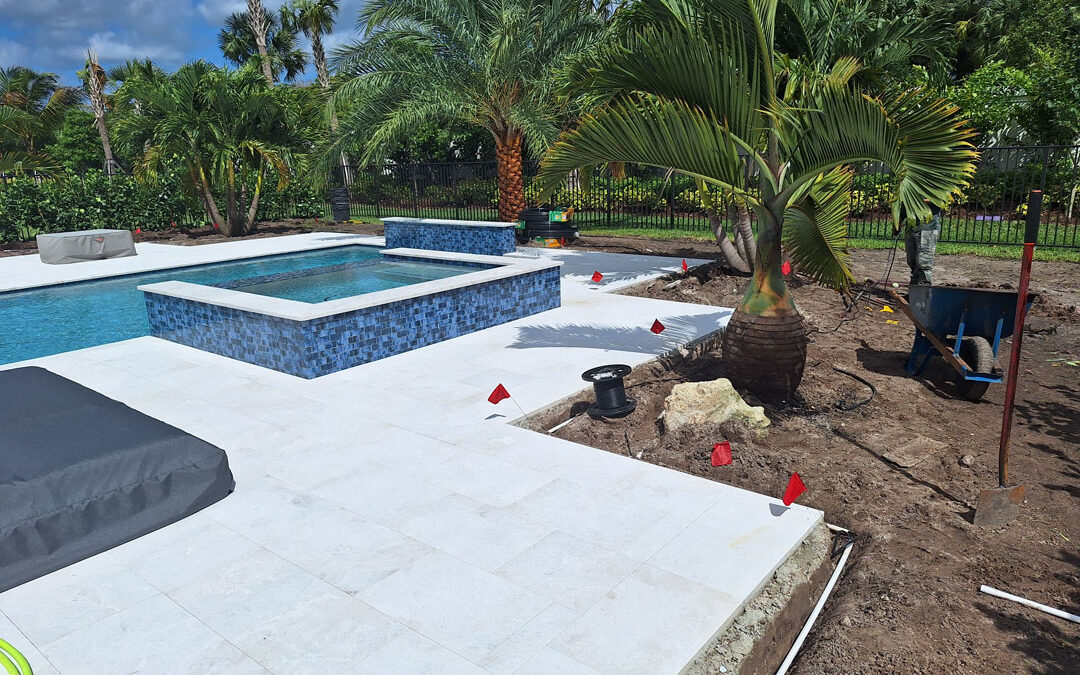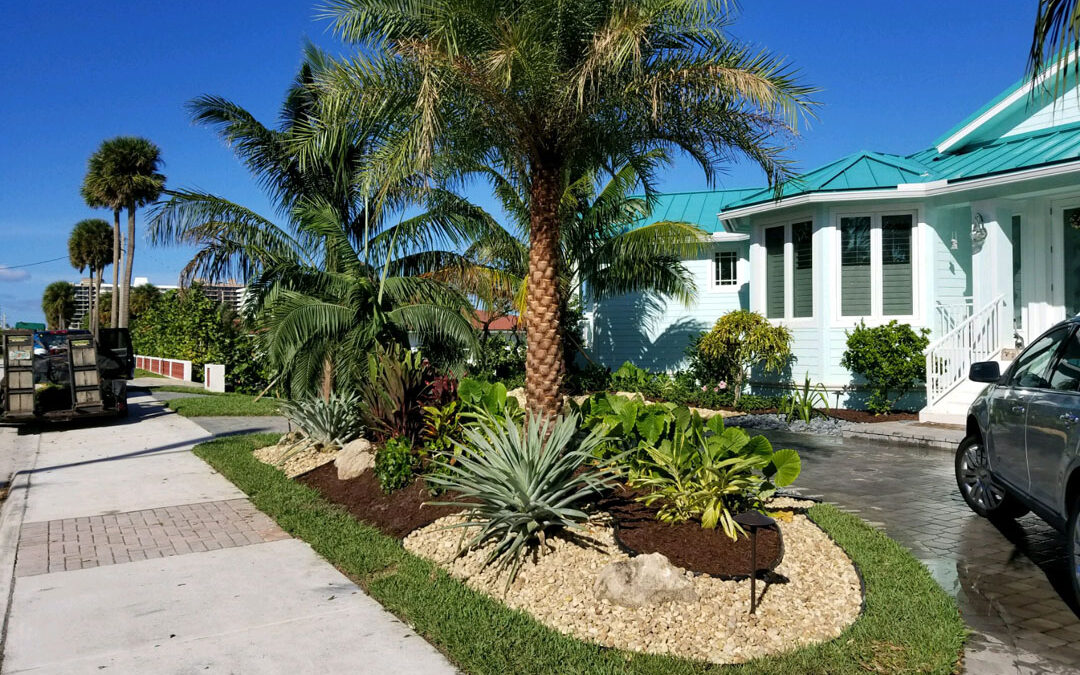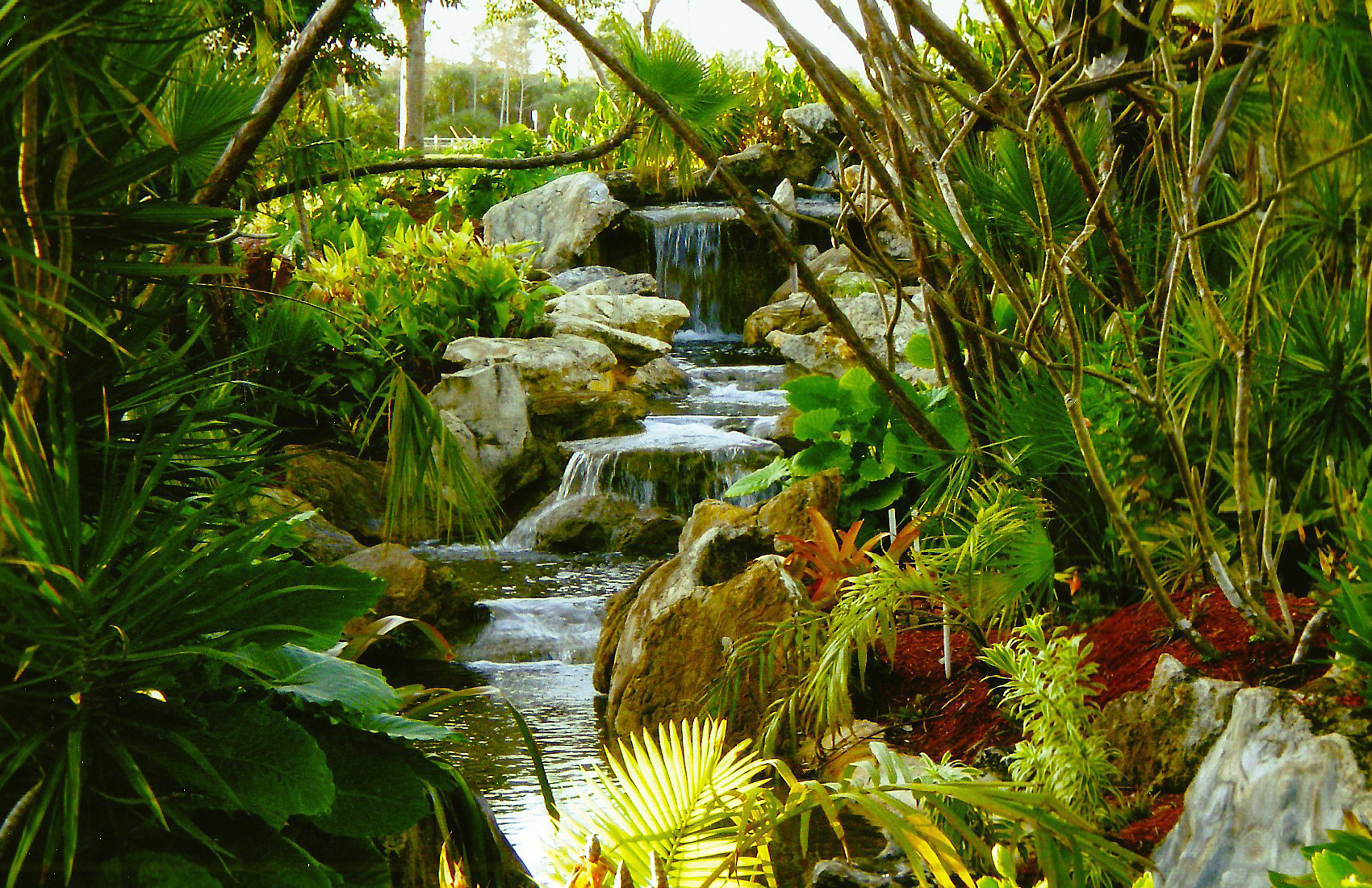As this article is part of a series on how to get my plants and trees to bloom better and to understand aspects of blooming and flowering production in plants and trees more, in an effort to be helpful to our clients and any reading, we receive most questions regarding the period immediately following a new landscape installation.
Simply, a plant going through stress, for any multitude of reasons can have an effect reducing bloom outputs. Yellowing of leaves or Chlorosis can range from being a situation of absolutely no concern to one of a sign that something is wrong and needs to be addressed. We’re going to try to help identify both ranges of this spectrum; to realize when little concern is needed and points when Yellowing leaves or Chlorosis can actually be a helpful warning sign to make adjustments when a landscape plant or tree is in need of help and beginning to find out why.
We’ll look at this topic of Yellowing leaves, Chlorosis in 2 general parts. The first part is to address that Yellowing leaves can be a natural part of the life cycle of a plant or trees life at any point in its life span, or it can be something else and a time to be aware that there is something wrong and if corrective treatments can be made, it would be a good time to do so.
We’re going to cover both the natural part of why and when and what kind of Yellowing or Chlorosis that might occur in some instances is ok and natural such as in as a younger new landscape verses yellowing leaves in an established landscape. Also, when the Yellowing leaves might actually be a way the plant or tree is letting you know it might need help or there’s something wrong.
////////////
To put it simply, the causes for a lower bloom output of flowers for any plant or tree can run through many similar issues and causes of concern for the yellowing or Chlorosis of leaves on plants and trees. The same variety of issues from being newly installed, being the nature of the plant, to soil, nutritional or drainage challenges, insect issues or diseases, or neglect for example.
The new Installation phase of being acclimated and seeing Yellowing of leaves or a drop off in blooms being a factor of the installation we could say typically the first Three Months after installation as the largest period of Acclimation for the new landscape. The first weeks through the first three months being the most intense period of acclimation which is why we say if there is a problem in a new landscape it will usually show up in the first three months. Beyond that, Yellowing leaves, or a lower bloom output could be attributed to some landscapes still acclimating and can still be a factor six months, even a year later for some plantings and properties. Depending on the plantings and the circumstances with the soils, weather conditions and the property. Weather conditions being lack of rain or too much rain which could most notably cause strain.
Both of these conditions can be existing either by being at a natural point in the plant or tree’s life cycle, or they can be present because of some other influencing conditions.
What is Chlorosis or Yellowing Leaves ?
Chlorosis is recognized commonly by a lack of healthy green, a yellowing in the naturally green leaf of a plant or tree. To note, not all plants have green leaves, for our topic here, we’re referring to green leaf plants and trees, and they could be with our without flowers or blooms.
A more direct definition of Chlorosis :
“Chlorosis is the yellowing of leaves caused by a lack of chlorophyll. Chlorophyll is the “green” that trees synthesize from sunlight’s energy and the water and nutrients taken up by a ..(plant or).. tree’s root system. It’s what makes ..(plant or).. tree leaves green.
Green leaves turn yellow (become chlorotic) when a tree takes up too few mineral nutrients and doesn’t synthesize enough chlorophyll.” Reference Credit : Article, “Chlorosis in trees and shrubs : Symptoms, causes & treatment. https://www.independenttree.com/chlorosis/#:~:text=What%20is%20chlorosis?,showing%20clear%20signs%20of%20chlorosis
Another way of understanding Chlorosis :
“Chlorosis is simply another term for yellowing. You are most likely to come across the term in descriptions of nutrient deficiencies or plant viruses (another term used commonly in such descriptions is necrosis, meaning cell or tissue death). However, there are many more possible causes of chlorosis than just viruses or nutrient problems.” Reference Credit : Article, “Chlorosis”, by RHS, Royal Horticultural Society, https://www.rhs.org.uk/problems/chlorosis
What might cause Chlorosis is either a lack of nutrition which is a common cause of this situation, or the list of common causes listed in this article as points we are covering; Soil conditions, root strength, drainage, pests, viruses or disease, etc or Necrosis or the natural dying off of the plants leaves as a part of re-generation or end of life. Another point of stress, lack of nutrition can be present naturally when a new andscape is first installed into a property and the root systems have yet to become acclimated. We note the first 3 months as the most important part of this new acclimation period for new landscapes and the process of acclimating can be longer for some properties in our South Florida area for larger trees, up to six months or a year, or in cases with landscapes and properties that have poor, dense soils and challenging drainage issues or problems.
An Important point on Chlorosis or Yellowing of leaves
When looking at the yellowing of the leaves of plants, a point that can not be understated is that there may be absolutely nothing wrong with the plant or tree. This point is made more for those who are new to caring for plants and trees, who are new to discovering the wide, wide world of horticulture and caring for a landscape, the lawns, plants, palms, trees and this new ecosystem being introduced.
For some, it may seem overwhelming at first, wishing to do well, a sense of a need to learn and there are so many different aspects of nature. This article is meant to help, and one phrase that will be repeated throughout many of these articles we write is that while there are reasons and conditions for challenges to landscapes we will cover; nature is ultimately stronger and more resilient quite often, than most people may think or realize. If it weren’t so, it would be extremely difficult to provide a warranty.
We provide general instructions in our “Landscape Care Notes” which take our clients through the standard watering schedules after installation with a long term strategy. Also included in the Landscape Care Notes Article are trimming, fertilizing care, weeding guidelines and other tips” which are available as a base guide for getting a good, healthy start for the great majority of new landscape installations with a guide to long term, beautiful landscape and property. Some properties and landscapes, plants, palms and trees can need tweaking based on soil conditions, drainage challenges and materials installed in our South Florida area, however, those that follow the instructions verses those that don’t, those who do we have consistently seen much more robust, healthier, longer lasting and beautiful landscapes, hands down.
Our Landscape Care Notes & Guidelines we provide as a reference for all of our clients of new landscape installations below here in this link :
Yellowing leaves as Natural Leaf Re-generation, a normal life cycle process that repeats during the life of the plant or tree
So, this point on yellowing leaves is taking a moment for that person learning, and saying that yes, it is possible that something could be wrong with the plant or tree, not to discard, but the simple turning of a leaf to yellow and brown is also a natural process of the life cycle in nature.
Every plant and tree that lives, will die. Even the longest lasting, above average health, beauty and longer life cycle of any particular species of plant, palm or tree will still go through this process of self re-generation. Older leaves will yellow, possibly brown first and fall, or yellow and fall. This will occur normally. With the dropping of older leaves, newer leaves are using that nutrition that is provided for new growth.
With new landscape installations, while the root systems are working to grow into the new soils of the new property, this is a major way that plants and trees are fed. While the supply of nutrition has been disrupted from the nursery or farm that the plants and trees came from, the newly planted landscape materials are now, top priority looking to replace that supply of nutrition. In the effort to reduce its need for nutrition, sometimes a plant or tree will drop leaves as a way of dropping its nutritional requirement after being planted. Yellowing leaves can proceed the browning of the leaves and dropping of those same leaves as a self defense and preservation mechanism, a means of natural survival or the quickest means through for a plant or tree to get through that initial period of less nutritional supply following an new landscape installation, as the root systems need to grow and produce a new, ongoing supply of nutrients.
This “shock” in a new landscape installation can be soft and mild, even hard to see in some landscape installations depending on the plant and tree materials chosen and the property and weather conditions of the new property, or they can be in increasing degrees from “No Concern”, to “Mild Concern”, to “Concern” or simple and quickly seen loss of a plant with a loss of chlorophyl in the branches, with brittleness and brown or dropped leaves throughout.
Heavy, sudden chlorosis or yellowing & dropping of leaves
This situation where a larger number of leaves than you’ve typically noticed turned yellow quickly, this can be concerning for a new landscape, especially concerning for a landscape plant or tree that has been established six months, a year or more. The longer the plant or tree has been established, the more years, the more concerning for this example of quick, significant leaf yellowing and leaf loss, if it is not fall or winter conditions for the cause of this for the particular plant or tree.
Even though experiencing a sudden, significant yellowing which we’ll say for conversation at over 30 percent or more than a third of the total leaves yellowing at once; this could happen and the plant, palm or tree can make it through and be fine, undamaged and live without a sign of any problem. Sometimes it might be righted on its own, there could be a momentary stress on a root system from digging nearby or construction that could have jostled or did some form of disturbance or damage to the root systems, could be an ant infestation or other insect that might be quickly and easily treatable if recognized soon enough, or it could be weather related strain from a lack of natural rainfall or an abundance of rainfall that is out of character for our area during any time of year. Example, low rainfall totals during the summer months when the temperatures are hotter will have a more visible effect on the landscapes than low rainfall totals during the winter months when the temperatures are lower.
Higher temperatures, more rain helps the landscapes adapt and grow better, they require more water to handle the hotter temperatures typically, than the landscapes will require during cooler months. So natural rainfall, even though you have an irrigation system, can have an effect of stress to a landscape.
A note here to read on and get your yard Xeriscaped with deeper root systems is a watering strategy to establish deeper roots, requiring less water and are hardier and longer lasting. We have other articles on our site on this subject and suggest every planting, everyone with a Going Green interest, go for Xeriscaping strategies which are not only plant choices, but more so, how to water properly, and to water less long term.
On the yellowing of the leaves, severity can be from a simple, nothing important notice of a few leaves, increasing to yellowing to maybe a third of the leaves turn yellow suddenly, which is of concern. Again, even the situation of concern might be ok, but we ask our customers if you experience yellowing or leaf loss of a third of a plant or tree suddenly and its not fall or winter season related, please send us close up and larger area planting photos by email asap. This will help us to record the time you notice it, and with the photos we’ll be able to see instantly what is going on most often. With this larger up to a third of leaf yellowing, it is a sign to keep an eye on the plant, palm or tree and start investigating possible reasons why.
It could be a number of issues ranging from nutrition deficiencies being somehow suddenly realized, or insects, disease or soil condition problems affecting the roots or the plant or tree that are compounding from poor or new drainage challenges from nearby, adjacent property construction possibly.
Regardless, if you see a third of the plant or tree drop its leaves suddenly, be on guard, it would prudent, if able to send an emailed photo(s) to, or set up an inspection with a professional in the landscape, horticulture or pest control industry that you may know or work with. There are also University of Florida, Extension Services which are set up at County Botanical Gardens in our South Florida area and are open to help support and serve the public, largely free of charge for many services as an immediate and accessible reference. An excellent source of information and support for any in our area with landscape / horticulture questions or challenges. Palm Beach County, Mounts Botancial Garden, West Palm Beach, FL.
////////////
Natural Life Cycle Expectancies of normal dying off of the plant or tree verses a Necrosis caused by a problem
Now, in a different point in the life of the plant or tree, the yellowing of the leaves, the Chlorosis, could be representing the natural end of the life of the plant, palm or tree. Now, a big question is what is the natural life expectancy of a plant ? What’s the natural life expectancy of a tree or palm?
There are so many different categories of plants and we’ll give a brief glimpse at that question with advice on how to help hopefully in getting the answer you need for your personal situation and your personal plant or tree in question.
This article is initially addressing the bloom production in plants and trees, however, when talking of plants, there are also edible plants such as vegetables and spices for example and those are not being covered in this effort. University studies or Horticultural Societies are usually an excellent source for information. Would try to find consistency in what you’re searching there if possible.
General Life Expectancies Guide : on Annuals flowers to Blooming Ground Cover plants, Perennial Plants & Bushes, Hedges and Blooming Bouganvilleas, from smaller palms & trees to larger Palms and Trees
Annual Flowers : With smaller annual flowers, the kind you might go to a garden store or a Home Depot or Lowes for example and buy some trays of flowers to brighten up an area in front of the house for a quick pop of color, they are usually smaller plants, maybe growing a foot or so tall, or shorter, depending on a wide variety of possible annual plants, and might have a life expectancy of a few months to a year on the longer end for some varieties possibly. Examples in our South Florida Area, Marigolds, Impatiens, Snapdragons, Vinca Flowers, Purslane for example.
Blooming Ground Cover Plants or Small Flowers that might last a year or two typically that might mature between a foot to 2 foot tall in our South Florida area, for example Penta Flowers, Blue Daze, Crossandra, Lantana varieties. Some might last longer than that.
Perennial Plants & Bushes: Those plants and bushes which might be a blooming plant that might grow from a foot to a few feet tall to some much larger, from a Plumbago to a Dombeya, or a Thryallis, an Ixora variety, Hibiscus bushes, Thumbergia or Tibochina, Canna Lilies, a large host of blooming options that you should hope to get 10 years or so with proper care. 10 to 15 years of life with many of these with proper care and that is stressed – “WITH PROPER CARE” to watering, trimming and fertilizing, weeding is a common goal and standard that should be sought after. It can be exceeded as well in some properties and conditions.
Hedges, for bushes or hedges, non blooming, or Bouganvillea, you should hope to get a generation (20 years) or more out of these in South Florida.
Palms & Trees, for smaller and larger species; a generation at the lower end. Larger palms and trees you should hope for multiple generations of life.
Recognizing Necrosis in Plants
“What is necrosis in plants? Essentially, necrosis is the scientific term for the death of plant tissue. Necrosis usually occurs in a specific area, like leaves, roots or stems. Often associated with bacteria, viruses, fungi or parasitic insects, necrosis can also be caused by watering plants too much or too little, lack of nutrients or improper amounts of sunlight. Conditions leading to necrosis depend on the plant species, as tolerances to diseases and requirements for sunlight, water and nutrients vary widely across the plant kingdom.”
Reference & Article Credit : “What is the Definition of Necrosis in Plants?”, by Christina Sloanne, updated March 24,2022; https://www.sciencing.com/the-definition-of-necrosis-in-plants-12003546/
When talking about Necrosis, we’re not talking about the natural life cycle of the plants and trees. You might see a number of different conditions, from pests to viruses contributing to the decline of the plant or tree. Necrosis, or the pre-mature death of the plant or tree could be a result of possible drainage problems that weaken the roots and provide nutritional challenges at the same time. As these points cover many different aspects of the dying off of the tissue of the plant or tree evident in the leaves, stems or branches, this definition here is suggestion that it is not the natural dying off of the plant or tree, but by a cause that is shortening its typical life longevity.
Again, for situations as these, beyond educating yourself, as proper recognition of the problem may increase the chances for an effective specific course of action and treatment, beyond the research you’re doing, check with a local, experienced professional who is versed in dealing with the problem or the conditions your plant(s) or tree(s) are facing and / or going through. Local University Extension services in our area by the University of Florida here in our South Florida counties is an excellent source to accompany the opinion of different professionals as well that can be available.

